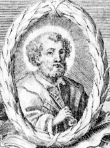
Jean Hardouin (1646-1729) was not himself a forger, but he was the author of an unusual theory about forgery. As librarian of the Lycee Louis-le-Grand in Paris, he came to the conclusion that virtually all classical texts, and most ancient works of art, coins and inscriptions, had been forged by a group of thirteenth-century monks led by a mysterious figure whom he called Severus Archontius. The goal of this group was supposedly to "establish Atheism amongst men, by paganising all the facts of Christianity". The name Severus Archontius was probably a veiled reference to the Holy Roman Emperor Frederick II of Hohenstaufen.
Hardouin was, at the time he first proposed his theory in 1693, a highly regarded scholar. Other learned men tried to take him seriously and argued the merits of his theory with him, but as he persisted in his views, he gradually came to be seen as a pariah in the scholarly community. One contemporary described him as "very confident, arrogant, and violently addicted to hypothesis and paradox." His critics referred to his theory dismissively as "Harduinismus".
Hardouin claimed he "detected the whole fraud" by spotting a series of clues embedded in classical works, clues that included instances of poor writing as well as apparent anachronisms. He believed the thirteenth-century forgers had not only forged the core classical texts, but also a range of later references to these texts, thereby creating a vast web of mutually reinforcing deception.
A nineteenth-century historian remarked that, "The legitimate inference from his theory is that he wished to establish Romanism on the ruins of universal learning, and to reduce mankind to an implicit submission to the Popedom: for, to the obvious question, which he states himself, 'If we must not believe the Fathers, whom can we believe?' he boldly replies: 'Not the Fathers, I say, but our Holy Mother the Church of Rome.'"
Viewed in a broader context, Hardouin's theory can be seen as an extreme expression of a growing awareness amongst seventeenth-century scholars of the number of errors, exaggerations, and inventions in the historical record.
Links and References

 Jean Hardouin (1646-1729) was not himself a forger, but he was the author of an unusual theory about forgery. As librarian of the Lycee Louis-le-Grand in Paris, he came to the conclusion that virtually all classical texts, and most ancient works of art, coins and inscriptions, had been forged by a group of thirteenth-century monks led by a mysterious figure whom he called Severus Archontius. The goal of this group was supposedly to "establish Atheism amongst men, by paganising all the facts of Christianity". The name Severus Archontius was probably a veiled reference to the Holy Roman Emperor Frederick II of Hohenstaufen.
Jean Hardouin (1646-1729) was not himself a forger, but he was the author of an unusual theory about forgery. As librarian of the Lycee Louis-le-Grand in Paris, he came to the conclusion that virtually all classical texts, and most ancient works of art, coins and inscriptions, had been forged by a group of thirteenth-century monks led by a mysterious figure whom he called Severus Archontius. The goal of this group was supposedly to "establish Atheism amongst men, by paganising all the facts of Christianity". The name Severus Archontius was probably a veiled reference to the Holy Roman Emperor Frederick II of Hohenstaufen.
Comments